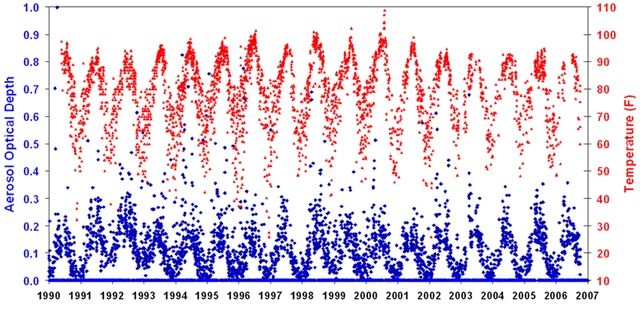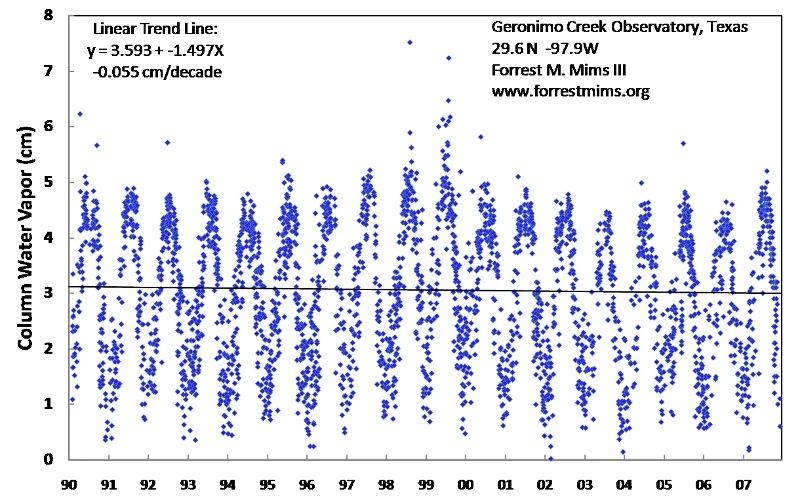|
|
SUN AND SKY SCIENCE DATA
The data plots at www.forrestmims.org will eventually be updated to include 1990 through 2012 and moved here. (The first such plot is below.) The long range plan is to eventually display most of the data and sun and sky photos from Geronimo Creek Observatory, Texas, and during annual calibration trips to Mauna Loa Observatory, Hawaii, and during field trips to Brazil, Alaska, Switzerland, Mexico, Japan and various portions of the mainland United States. The data below include some of the time series of data collected at Geronimo Creek Observatory at or near local solar noon when the Sun was unobscured by clouds. All data shown here have been previously published or discussed in peer-reviewed papers with the exception that these data are updated through 2007. Nearly all data were collected by Forrest M. Mims III. Some data points are by Minnie C. Mims, Eric R. Mims, Vicki R. Mercer and Sarah A. Mims.
1. Aerosol Optical Thickness (1990-2007)

The Aerosol Optical Thickness (AOT) or Aerosol Optical Depth (AOD) is a haze index. AOT is a dimensionless logarithmic term that expresses the attenuation of a direct beam of sunlight caused by atmospheric aerosols (microscopic droplets and particles of dust, smoke, sulfate, salt, pollen, etc.). A high value means the sky is hazy. A low value means the sky is clear. Note that AOT (blue in time series below) has a distinct annual cycle. The sky is much cleaner during winter than during summer. Note how this is closely associated with temperature. Note also how the AOT during the winters of 1991 and 1992 was higher than normal because of the eruption of Mount Pinatubo. The reduction in temperature (red in time series below) following the eruption (June 1991) is quite obvious, as is the gradual recovery to normal levels. Various spikes in AOT are from regional pollution events, Mexican smoke and dust storms from West Texas, North Africa and Asia that reach Texas. The calibration of the instrument is based on annual Langley plots conducted at the Mauna Loa Observatory in Hawaii most years since 1992. The instrument design and calibration is described in F. M. Mims III, Sun Photometer with Light-Emitting Diodes as Spectrally Selective Detectors, Applied Optics, 31, 33, 6965-6967, 1992. See the Publications page at www.forrestmims.org for more recent papers by me and by David Brooks and me.
2. Total Column Water Vapor (1990-2007)

The total water vapor column or precipitable water (PW) is the amount of water vapor in a vertical column from the surface to the top of Earth's atmosphere. Column water vapor is expressed in terms of the depth of liquid water produced if all the vapor in the vertical column is condensed as a liquid at standard temperature and pressure. PW at Geronimo Creek ranges from as low as a few mm to more than 60 mm. Water vapor is by far the most potent of the greenhouse gases. Thus, long term changes in PW might reflect changes in climate. At this site the trend is -0.055 cm per decade, which suggests a very stable long-term trend. Note the sharp increase in PW during 1999 in the time series. Note also the comparatively low PW during 2003. These data are from the first Sun photometer to use light-emitting diodes as spectrally-selective photodiodes. Thus, this instrument is not subject to significant long term drift. These data are based on new calibrations conducted in 2002 against the NOAA GPS water vapor instrument at White Sands Missile Range, New Mexico, and the Goddard Space Flight Center Aeronet Cimel Sun photometer at Mauna Loa Observatory, Hawaii. Since 2006 a comparison is being made with a NOAA GPS PW site at the San Marcos Airport (Texas). Results are very good. The instrument originally cost about $20. It's design is described in F. M. Mims III, Sun Photometer with Light-Emitting Diodes as Spectrally Selective Detectors, Applied Optics, 31, 33, 6965-6967, 1992. See also David R. Brooks, Forrest M. Mims III, and Richard Roettger, Inexpensive Near-IR Sun Photometer for Measuring Total Column Water, Journal of Atmospheric and Oceanic Technology 24, 1268–1276, July 2007. A new paper in preparation describes new calibration results and the instrument's long-term sensitivity.
Please see www.forrestmims.org for additional data that will eventually be moved here.
|